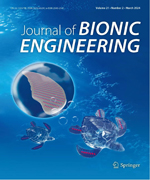The four topics are described including the driving force and source of the scientific and technological creation, the definition and history of the bionics, the important significance of bionics in the development of the human beings, and the leading edge and progress of bionics. The appetency of human for the creation is the essential motivity of the innovation in science and technology. Nature and society are the objects for us to cognize and serve, meanwhile, the best teachers for us to learn from them. It is only 5 million years for human's development, but evolution of lif e has over 3.5 billion years history. Although, copying the creation from the human being is important, however, it has much more potential and opportunity in imitating the nature, and more possibility to promote the ability of original innovation. The significance and progress of bionics are summarized, in this paper, and the leading edges of bionics, in the near future, are forecasted.

 Table of Content
Table of Content
 Table of Content
Table of Content